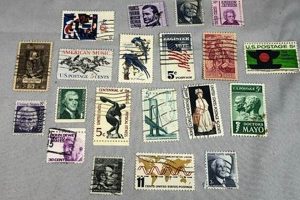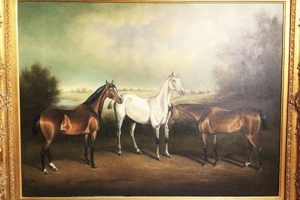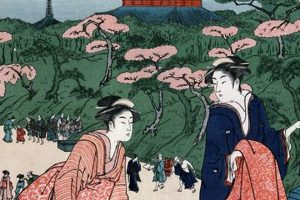The artwork in question represents a distinct genre characterized by idealized depictions of women, often glamorous and alluring, produced primarily during the mid-20th century. These images, frequently printed on posters, calendars, and magazines, were intended to be displayed informally, hence the “pin-up” designation. A prominent example includes the illustrations of Gil Elvgren, renowned for his technically skilled and subtly humorous portrayal of feminine charm.
The significance of this artistic style lies in its reflection of societal ideals and cultural trends of its time. It provided escapism and entertainment for soldiers during wartime and later influenced advertising and fashion. Furthermore, it offers valuable insight into the evolving perceptions of femininity and beauty standards throughout the 20th century. Its impact extends to contemporary art and design, where elements of its aesthetic are often reinterpreted and celebrated.
Understanding this artistic form provides a foundation for exploring its individual artists, notable works, and its lasting impact on subsequent artistic movements and visual culture. Subsequent sections will delve further into specific artists who helped define the genre and examine specific iconic examples.
Insights into the Genre’s Characteristics
The following points offer specific guidance for recognizing and appreciating the nuances of this artistic category.
Tip 1: Focus on Idealized Realism: The portrayals, while inspired by reality, tend toward idealized representations of the human form and setting. Attention is given to flattering poses and meticulously crafted details.
Tip 2: Recognize the Era-Specific Fashion and Styling: The clothing, hairstyles, and accessories are indicative of the 1930s to 1960s period. Studying fashion trends from these decades enhances the viewer’s ability to contextualize the artwork.
Tip 3: Analyze the Narrative Element: Many examples convey a subtle narrative, often humorous or suggestive, through the pose, expression, and surrounding environment of the subject. Deciphering this implied story adds depth to the interpretation.
Tip 4: Note the Importance of Composition and Lighting: Artists in this genre demonstrated proficiency in composition, utilizing techniques to draw the eye and create a sense of dynamism. Lighting is often used to accentuate curves and create a sense of glamour.
Tip 5: Understand the Context of Mass Production: The intent for mass production via printing influenced artistic choices. Bold colors and clear lines were favored to ensure impactful reproduction across various media.
Tip 6: Study Key Artists: Familiarizing oneself with the works of prominent figures like Gil Elvgren, Alberto Vargas, and George Petty provides a framework for understanding the diversity within the genre and the individual styles of each artist.
Mastering these aspects facilitates a deeper appreciation for the artistic skill, cultural significance, and enduring appeal of this particular form.
The following sections will delve into the lasting impact of the artwork and its enduring relevance.
1. Idealized Femininity
Idealized femininity forms a core tenet within the realm. This concept, central to the genre’s appeal and cultural impact, represents a specific and carefully constructed vision of womanhood that permeated much of mid-20th century visual culture. The representations were less about accurate portraits of women and more about crafted symbols of aspiration, desirability, and perceived social roles.
- Hourglass Figure Emphasis
A pronounced hourglass figure, characterized by a small waist and accentuated curves, was a recurring motif. This physical attribute, often achieved through strategic posing and clothing, became synonymous with beauty and health. Artists like Gil Elvgren frequently utilized this body shape to create a sense of visual harmony and appeal, reinforcing the ideal within popular culture.
- Innocence and Playfulness
While the subjects were often depicted in alluring poses, the overall presentation usually incorporated elements of innocence and playfulness. This combination tempered the overt sensuality, making the images more palatable to a broader audience and aligning with the prevailing social mores of the time. Subtle gestures, coy expressions, and depictions of lighthearted activities contributed to this impression.
- Emphasis on Grooming and Presentation
Meticulous attention was paid to grooming, including hairstyles, makeup, and clothing. These elements served to enhance the overall impression of sophistication and refinement. The subjects were consistently portrayed as impeccably dressed and styled, reinforcing the notion that beauty required effort and careful presentation.
- Domesticity and Leisure
The settings in this art often placed the subjects in domestic or leisure environments, further reinforcing traditional gender roles. While the women were undeniably attractive, their activities and surroundings often implied a connection to home and family. This juxtaposition of glamour and domesticity contributed to the complex and often contradictory nature of the idealized feminine image.
Collectively, these facets demonstrate the calculated construction of idealized femininity within this artwork. It reveals a vision of women that, while aesthetically pleasing, was deeply intertwined with societal expectations and cultural norms of the mid-20th century. The enduring appeal of this style highlights the lasting power of these carefully crafted images and their ongoing influence on contemporary perceptions of beauty and femininity.
2. Commercial Illustration
Commercial illustration served as the primary vehicle for disseminating pin-up imagery. The genre existed almost exclusively within the framework of advertising, magazines, calendars, and other mass-produced media. Its economic viability hinged on its ability to attract consumer attention and drive sales. This commercial imperative directly influenced the aesthetic choices and thematic content of the artwork. For example, artists like Gil Elvgren received commissions from companies like Coca-Cola to create illustrations that subtly incorporated the brand’s products, linking the idealized figures to consumer goods. The pervasive presence of these images in everyday life highlights the integral role of commercial illustration in shaping the genre’s popularity and cultural reach.
Furthermore, understanding this connection is crucial for analyzing the visual language of the artwork. The poses, expressions, and settings were carefully crafted to appeal to a target audience, typically male consumers. The images often presented a fantasy world of leisure and idealized beauty, designed to evoke desire and aspiration. The skills of commercial illustrators, including expertise in anatomy, composition, and color theory, were applied to creating compelling and memorable images that stood out in a crowded marketplace. The techniques used in these pieces often mirror those employed in other forms of advertising, emphasizing the genre’s deep roots in the world of commerce.
In summary, the bond between the artistic style and commercial illustration is undeniable. The artwork’s existence as a widespread cultural phenomenon depended entirely on its function as a tool for advertising and promotion. Recognizing this relationship provides vital context for interpreting the artwork’s visual cues, understanding its intended audience, and appreciating its impact on the broader cultural landscape. It challenges viewers to consider the influence of commercial forces on artistic expression and the ways in which idealized images can be used to shape consumer behavior.
3. Mid-Century Sensuality
Mid-Century Sensuality, a distinct characteristic, profoundly shaped the aesthetic and cultural impact of its artwork. This period, spanning roughly from the 1940s to the 1960s, witnessed evolving attitudes toward sexuality, subtly reflected in the portrayal of women within the genre. The sensuality embedded in the artwork, however, was carefully calibrated to conform to the era’s social boundaries, often conveyed through implication and suggestion rather than overt explicitness.
- Implied Allure
The allure conveyed was often indirect, relying on suggestive poses, coy expressions, and subtle displays of the female form. The garments worn, while sometimes revealing, typically adhered to a code of modesty. Bare shoulders, exposed legs, and form-fitting dresses served to accentuate the figure while maintaining a degree of decorum. This approach allowed the images to titillate without violating the prevailing social standards.
- Healthy Idealism
The sensuality was often intertwined with notions of health and vitality. The figures were frequently depicted as athletic and energetic, embodying a sense of physical well-being. This emphasis on health served to legitimize the sensual aspects of the artwork, presenting the women as embodiments of wholesome beauty rather than simply sexual objects. Advertisements featuring these images frequently promoted products associated with health and fitness, reinforcing the link between physical well-being and attractiveness.
- The Gaze and Power Dynamics
The power dynamics inherent in the male gaze played a significant role in shaping the depiction of sensuality. The artwork was primarily targeted toward male audiences, and the subjects were often presented as objects of male desire. However, the best artists were also skilled at imbuing their subjects with a sense of agency and self-possession, challenging the simplistic notion of women as passive recipients of the male gaze. This nuance contributes to the complexity and enduring appeal of the genre.
- Escapism and Fantasy
The sensuality provided a form of escapism and fantasy, offering a glimpse into a world of idealized beauty and romance. During times of war and social upheaval, these images offered a welcome distraction from the harsh realities of everyday life. The artwork conjured a sense of optimism and possibility, reminding viewers of the pleasures and joys that life could offer. The depiction of exotic locales and glamorous settings further enhanced the escapist appeal.
The multifaceted nature of sensuality during this era profoundly influenced the aesthetic and cultural significance. By understanding these nuances, one can gain a deeper appreciation for the ways in which the artwork reflected and shaped attitudes toward sexuality, gender, and beauty during the mid-20th century. The subtle complexities of the genre contributed to its enduring popularity and its ongoing relevance in contemporary discussions about representation and the body.
4. Wartime Morale
The exigencies of wartime necessitated strategies to maintain troop morale. “Pin up vintage art” served as a tool to foster a sense of connection to home and to provide an aspirational focus amidst the harsh realities of conflict. These images offered a visual respite and a reminder of the values and desires for which soldiers were ostensibly fighting.
- Psychological Comfort
The deployment of such art offered psychological comfort. The idealized representations of women, often embodying qualities of beauty, grace, and domesticity, provided a counterpoint to the anxieties and deprivations of war. Pin-ups were frequently displayed in barracks, mess halls, and even aircraft, serving as tangible links to a world outside the immediate environment of combat.
- Symbolic Representation of Home
These images served as symbolic representations of home and the life soldiers hoped to return to. The women depicted often embodied idealized versions of wives, girlfriends, and mothers, providing a visual anchor to familial connections and civilian life. The presence of these images reinforced the motivation to endure the hardships of war and to return home safely.
- Promotion of National Values
Beyond personal connections, this art also promoted national values and ideals. The women were often depicted as patriotic figures, symbolizing the values and freedoms for which the nation was fighting. This served to reinforce the sense of collective purpose and to strengthen the bond between soldiers and their country. The images were often accompanied by slogans and patriotic messages, further amplifying their impact.
- Distraction and Entertainment
The function extended to simple distraction and entertainment. In periods of downtime, the images offered a form of visual entertainment that helped to alleviate boredom and stress. The artistry and attention to detail in these images provided a welcome escape from the monotony and harshness of military life. The images were often collected and traded among soldiers, fostering a sense of camaraderie and shared experience.
The connection between the artwork and wartime morale is clear. It provided psychological comfort, symbolized home, promoted national values, and offered distraction. The deployment of these images served as a strategic tool for maintaining troop morale and fostering a sense of connection to the values and desires for which soldiers were fighting. The enduring popularity of the genre reflects its profound impact on the cultural landscape of the wartime era.
5. Advertising Influence
The intersection of commercial advertising and the artistic style is a cornerstone of its widespread popularity and cultural impact. This influence shaped the imagery, themes, and dissemination methods, transforming what might have remained a niche art form into a ubiquitous element of mid-20th century visual culture. The symbiotic relationship between commercial interests and artistic creation necessitates a careful examination of the specific ways in which advertising shaped the form and function of the genre.
- Product Endorsement and Integration
Advertisements skillfully integrated the images with product endorsements. The idealized figures were frequently depicted using or interacting with specific products, ranging from cosmetics and clothing to automobiles and household appliances. This association aimed to transfer the perceived qualities of the figuresbeauty, glamour, and sophisticationto the advertised product, thereby increasing its desirability and sales. Coca-Cola, for example, employed this art style to promote its beverage by portraying the figures enjoying the drink in idyllic settings, associating it with leisure and happiness.
- Targeted Marketing Campaigns
The artistic style became a key component of targeted marketing campaigns designed to appeal to specific demographics. Advertisers understood the power of these images to capture the attention and imagination of particular groups, such as soldiers during wartime or young men seeking entertainment and aspirational role models. Calendars, magazines, and posters featuring the imagery were distributed widely through channels that catered to these target audiences, maximizing the reach and effectiveness of the advertising messages. Army bases and mechanics shops were often adorned with these art styles targeting the workers and consumer inside.
- Shaping Consumer Aspirations
Advertisements utilized the aesthetic to shape consumer aspirations and reinforce societal ideals. The idealized figures represented not only physical beauty but also a particular lifestyle and set of values. Consumers were encouraged to emulate the figures through the purchase of specific products and the adoption of certain behaviors. This advertising strategy played a significant role in shaping cultural norms and influencing consumer behavior during the mid-20th century. The portrayal of women became a beauty standard during that time.
- Standardization of Visual Language
The advertising industry contributed to the standardization of the visual language used in this art style. The repetition of certain themes, poses, and compositional techniques across numerous advertisements created a recognizable and easily accessible visual shorthand. This standardization facilitated the rapid dissemination of the images and reinforced their impact on popular culture. While individual artists maintained their unique styles, they also adhered to a set of conventions that were dictated by the demands of the commercial marketplace.
The pervasive influence of advertising on this art is undeniable. It transformed the genre from a simple artistic endeavor into a powerful engine for shaping consumer behavior, reinforcing cultural norms, and disseminating aspirational ideals. Understanding this relationship is essential for comprehending the genre’s historical significance and its lasting impact on contemporary visual culture. The effects can still be seen and studied in modern day advertising.
6. Glamour Aesthetic
The glamour aesthetic constitutes a foundational element, shaping its visual appeal and cultural resonance. This aesthetic, characterized by idealized beauty, sophistication, and an air of allure, permeates the imagery, influencing everything from the pose and expression of the subjects to the styling and composition of the artwork. The pursuit of glamour was not merely about depicting physical attractiveness; it involved the construction of a carefully curated image designed to evoke aspiration and desire. For example, artists frequently employed techniques such as soft lighting, flattering angles, and meticulous attention to detail to enhance the subject’s appearance and create an impression of unattainable perfection. The popularity of magazines such as Vogue and Harper’s Bazaar during the same period showcases the widespread cultural fascination with glamour and its influence on fashion and visual culture.
The practical significance of understanding this aesthetic lies in its ability to illuminate the genre’s purpose and impact. The imagery was inherently designed to appeal to a specific audience, often male consumers, by presenting an idealized vision of femininity that aligned with prevailing social norms and desires. The inclusion of luxurious accessories, elegant clothing, and exotic settings further amplified the glamour quotient, creating a fantasy world that resonated with viewers seeking escapism and inspiration. Furthermore, the study of the glamour aesthetic within this context provides valuable insights into the evolution of beauty standards and the construction of gender roles in the mid-20th century. For instance, the prevalent use of makeup and hairstyling techniques reflects the growing emphasis on personal presentation and the commercialization of beauty during this period. A real-world example is how Maybelline, a rising company, sold its cosmetic to many women through the means of advertising and influence.
In conclusion, the glamour aesthetic serves as a crucial lens through which to analyze the imagery and its cultural significance. The construction of idealized beauty, the influence of commercial forces, and the reflection of societal norms all converge within this aesthetic, shaping its enduring appeal and its complex legacy. While the concept of glamour has evolved over time, its fundamental principles of aspiration, allure, and visual sophistication remain central to the understanding and appreciation of this art form. The challenges lie in critically assessing the historical context and recognizing the potential for these images to reinforce outdated beauty standards and gender stereotypes. Nonetheless, the study of the glamour aesthetic provides valuable insights into the history of visual culture and the ongoing evolution of perceptions of beauty and femininity.
7. Evolving Standards
The interpretation and appreciation of this art form are inextricably linked to evolving societal standards concerning beauty, representation, and gender roles. The initial popularity of this artwork stemmed from its alignment with the prevailing aesthetic norms of the mid-20th century. However, as societal values have shifted, so too has the perception of these images, necessitating a critical reassessment of their cultural significance. The shift from celebrating idealized forms to embracing body positivity movements exemplifies the evolving lens through which the art is now viewed. Images that once served as benchmarks of beauty are now subject to scrutiny regarding their potential to promote unrealistic or harmful expectations.
The ongoing dialogue surrounding the artistic style illustrates the practical significance of understanding evolving standards. Museums and galleries exhibiting such pieces often provide contextual information addressing the historical context and potential problematic aspects of the imagery. Art historians and cultural critics contribute to this evolving understanding by analyzing the artwork through contemporary lenses, examining its impact on issues such as body image, objectification, and the perpetuation of gender stereotypes. The critical examination of Alberto Vargas’s work, for example, often involves discussions about the male gaze and its influence on the portrayal of women. Exhibitions now aim to present the art in a way that acknowledges its historical significance while also prompting critical reflection on its legacy.
In conclusion, the value and interpretation of such artwork are fluid, contingent upon the evolving standards of society. Engaging with this art necessitates a balanced approach, acknowledging its historical context while critically assessing its implications in the light of contemporary values. Recognizing the impact of evolving standards allows for a more nuanced and informed appreciation of this particular art, fostering dialogue and promoting a deeper understanding of the complex relationship between art, culture, and societal values. These pieces should be viewed and studied through an academic and scholarly lens to create awareness.
Frequently Asked Questions about Pin Up Vintage Art
The following section addresses common inquiries and clarifies frequent misconceptions surrounding this artistic style.
Question 1: What defines a work as belonging to the pin up vintage art genre?
The artwork typically features idealized depictions of women, created primarily between the 1930s and 1960s, intended for informal display. Key characteristics include idealized realism, era-specific fashion, and a narrative element, often with a subtle or humorous tone.
Question 2: Who are some of the most influential artists associated with this style?
Prominent artists include Gil Elvgren, Alberto Vargas, George Petty, and Norman Rockwell. Each artist possesses a unique style, but all contributed significantly to defining the aesthetic and cultural impact of the genre.
Question 3: What was the primary purpose of the imagery?
The images were created primarily for commercial purposes, including advertising, magazine illustrations, and calendar art. They also served a role in boosting morale during wartime, providing soldiers with visual reminders of home and idealized beauty.
Question 4: How did societal standards influence the art?
Societal standards significantly shaped the portrayal of women, reflecting prevailing notions of beauty, femininity, and gender roles. As societal values evolved, the interpretation and appreciation of the artwork also changed, leading to critical reassessments of its cultural significance.
Question 5: What is the enduring legacy of the artistic style?
The art continues to influence contemporary art and design, serving as a source of inspiration and a subject for critical analysis. Its legacy lies in its reflection of mid-20th century cultural trends and its contribution to the ongoing dialogue about representation and beauty standards.
Question 6: Where can examples be viewed or studied?
Examples can be found in museums, art galleries, vintage magazines, and online archives. Academic journals and books offer critical analyses and historical context for understanding the art’s significance.
The answers above clarify misconceptions about this particular art form. The style represents a complex interplay of art, commerce, and evolving cultural values.
The following section explores recommended resources for further study.
Conclusion
The preceding analysis clarifies the multifaceted nature of “pin up vintage art” as a significant cultural artifact. The exploration of the genre’s characteristics, including idealized femininity, commercial roots, and evolving societal interpretations, provides a comprehensive understanding of its historical context and enduring influence. The examination of its role in wartime morale and its connection to the glamour aesthetic further elucidates its complex relationship with social values and consumer culture.
Continued study and critical engagement with “pin up vintage art” are essential for fostering a nuanced perspective on its place within art history and its ongoing relevance to contemporary discussions of representation and beauty. The genre serves as a valuable case study for understanding the interplay between art, commerce, and societal norms, encouraging further investigation into its lasting impact on visual culture and the evolution of aesthetic ideals.







